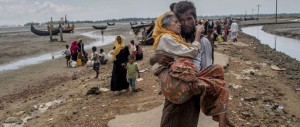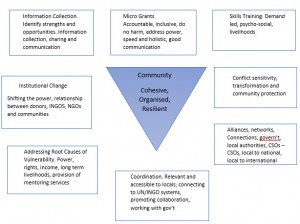How to build resilience during emergency response: piloting the START DEPP Linking Preparedness and Response in Emergency Contexts (LPRR) approach in Myanmar
By Becky Murphy @Christian Aid and @Kings College London
Image: Credit to Christian Aid and their Rohingya Crises Appeal: https://www.christianaid.org.uk/emergencies
On Friday 18 August 2017, the LPRR team headed out to Myanmar to launch a new, practical approach to localisation.
After two years of research and work, the team were very excited to start putting findings into practice in both Kayin and Rakhine in Myanmar. However, we were also a little wary, knowing that we were not going into the easiest of contexts to roll out a new approach to humanitarian response.
The approach is based on the six recommendations captured by the LPRR research which explored 327 crises survivor and first responders’ perception of how to strengthen humanitarian response to build (and not undermine) long term community resilience.
Here, Christian Aid and Kings College London then collaborated with Church of Sweden and Local to Global Protection to put this into practice and align:
- A survivor led, micro-grant response centred around community cohesion, wellbeing and psycho-social support,
- How to advocate for root causes to be addresses,
- Livelihoods to be established immediately and,
- Collaboration, communication and government relationships to be strengthened. (Quite ambitious to do during any emergency response).
However, on Friday 25 August 2017, an insurgent group calling itself Arakan Rohingya Salvation Army (ARSA) attacked 30 police posts in Rakhine, leaving 89 people dead. This triggered a counterinsurgency response from the Myanmar military, displacing 400, 000 people into Bangladesh. At the same time, violent protests were planned in Rakhine state against the UN and all (I)NGO’s. Exacerbating the tensions, on Monday, the 28th August 2017, Aung San Suu Kyi’s office accused aid workers of helping “terrorists” by responding to the Rohingya crises. Challenging yet apt timing for the pilot…
This escalation of violence and displacement and heightened level of anger towards aid work, put the LPRR partners into a heightened level of flux, stress and pressure. Whilst an incredibly challenging time for the LPRR project to be piloting a new, progressive and some may say radical approach to humanitarian response, it was also felt to be very apt time for us to be challenging the business as usual approach. Localising aid right to the community level, allowing community pop up groups to run the response and transferring funds straight into community groups or camps is argued not only to enable aid to be more efficient and relevant but can also empower crises survivors to strengthen community resilience. Crucially, it also enables aid to get to incredibly challenging locations where security or geography would usually prevent aid from reaching the most cut off, remote and vulnerable communities.
So, what is the approach?
The approach has eight components (illustrated below in figure 1) which are worked though in a six-day co-developed workshop. As you can see it is centred around community wellbeing and resilience. Here, participants work together to recognise the existing capacities and networks in a community and aim to build on and strengthen community cohesion.
We then work our way around the components: starting with information collection which is facilitated by community volunteers. We challenge the traditional needs assessment and focus on capturing existing strengths and capacities, systems and networks as well as gaps and additional needs. Then comes the transfer of resources through micro grants straight into the community. Here, community pop up groups put together mini proposals to run aspects of the humanitarian response.
We then move on to skills training; here crucial skills such as psycho -social support and how to immediately establish livelihoods are discussed and worked through. Additional skills training session can also be requested. This is complimented by a session on how to implement these micro grants with conflict sensitivity, addressing protection needs and meeting do no harm requirements.
The co-developed workshop then moves on how to work with and align with alliances, networks and the government. Next, we explore root causes of vulnerability and how the post disaster space can be utilised to advocate for and address key issues. Finally, institutional change is explored; this looks at the bigger picture and maps out what (I)NGOs need to do to implement localisation and shift the power right to the local level.
The workshop closes with a final day of practical planning. Here, partners put the steps into a practical plan, ready to implement immediately and the LPRR project transfers specific funds to pilot the approach in an immediate crises response.
What have we learnt?
This was the first pilot of the LPRR localisation in practice approach. Therefore, a number of lessons were learnt and reflected on. The amount of information and tools in the package made the workshop very intense and participants explained that it is important to show a visual aid (such as figure 1) to be able to clearly illustrate the components. Having the approach firmly centred around community wellbeing and resilience was felt to be a very clear foundation to keep returning to when thinking through each step.
It Is also important to have clear hands outs, translation into local languages, energisers and enough time for discussion. Participants reaffirmed the importance of good communication and psycho-social support in humanitarian response and the benefit of having both partners and community members in the training was highlighted. However, it was felt more time needed to be ringfenced to address good communication, how to work with the government and how to tackle root causes and re-establish livelihoods immediately after a response. It was also highlighted that more work needed to be done to explore the security implications for partners implementing this approach.
What is next?
Next, we take the approach out to Kenya. Here, we aim to apply the lessons learnt in Myanmar and work with partners to trial community lead response to the drought context in Marsabit and Maralal. For more information contact Becky Murphy at rmurphy@christian-aid.org or Simone Di Vicenz at Sdivicenz@christian-aid.org. For more information on Christian Aid’s response to the Rohingya crises take a look at their website: www.christianaid.org.uk/emergencies
Figure 1: The LPRR Steps

